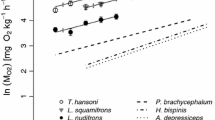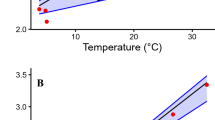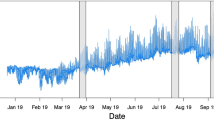Abstract
Environments where extreme temperatures and low productivity occur introduce energetically challenging circumstances that may be exacerbated by climate change. Despite the strong link between metabolism and temperature in ectotherms, there is a paucity of data regarding how the metabolic ecology of species affects growth and fitness under such circumstances. Here, we integrated data describing field metabolic rates and body condition of two sympatric species of ectotherms with divergent lifestyles, the benthic freshwater (or largetooth) sawfish (Pristis pristis) and the epipelagic bull shark (Carcharhinus leucas) occurring in the Fitzroy River, Western Australia, to test the implications of their differing metabolic ecologies for vulnerability to rising temperatures. Over a temperature range of 18–34 °C, sawfish had lower field metabolic rates (63–187 mg O2 kg−0.86 h−1) and lower temperature sensitivity of metabolic rates [activation energy (EA) = 0.35 eV] than bull sharks (187–506 mg O2 kg−0.86 h−1; EA = 0.48 eV). Both species lost body mass throughout the dry season, although bull sharks significantly more (0.17% mass loss day−1) than sawfish (0.07% mass loss day−1). Subsequent bioenergetics modelling showed that under future climate change scenarios, both species would reach potentially lethal levels of mass loss during dry season periods before the end of the century. These results suggest that ectotherms with low metabolic rates may be better suited to extreme environmental conditions, and that even small increases in temperature due to climate change could have substantial impacts on the ability of ectotherms to grow and survive in harsh conditions, including high temperatures and energy-limiting circumstances.





Similar content being viewed by others
References
Abram PK, Boivin G, Moiroux J, Brodeur J (2017) Behavioural effects of temperature on ectothermic animals: unifying thermal physiology and behavioural plasticity. Biol Rev 92:1859–1876. https://doi.org/10.1111/brv.12312
Auer SK, Dick CA, Metcalfe NB, Reznick DN (2018) Metabolic rate evolves rapidly and in parallel with the pace of life history. Nat Commun 9:14. https://doi.org/10.1038/s41467-017-02514-z
Baldridge HD Jr (1972) Accumulation and function of liver oil in Florida sharks. Copeia. https://doi.org/10.2307/1442493
Bates D, Maechler M, Bolker B, Walker S (2015) Fitting linear mixed-effects models using lme4. J Stat Softw 67:1–48. https://doi.org/10.18637/jss.v067.i01
Bernal D, Carlson JK, Goldman KJ, Lowe CG (2012) Energetics, metabolism, and endothermy in sharks and rays. In: Carrier JC, Musick JA, Heithaus MC (eds) Biology of sharks and their relatives, 2nd edn. Taylor and Francis Group, LLC, Boca Raton, pp 211–237
Bozinovic F, Catalan TP, Estay SA, Sabat P (2013) Acclimation to daily thermal variability drives the metabolic performance curve. Evol Ecol Res 15:579–587
Brown JH, Gillooly JF, Allen AP, Savage VM, West GB (2004) Toward a metabolic theory of ecology. Ecol 85:1771–1789. https://doi.org/10.1890/03-9000
Brownscombe JW, Cooke SJ, Danylchuk AJ (2017) Spatiotemporal drivers of energy expenditure in a coastal marine fish. Oecologia 183:689–699. https://doi.org/10.1007/s00442-016-3800-5
Butler PJ, Green JA, Boyd IL, Speakman JR (2004) Measuring metabolic rate in the field: the pros and cons of the doubly labelled water and heart rate methods. Funct Ecol 18:168–183. https://doi.org/10.1111/j.0269-8463.2004.00821.x
Byrnes EE, Lear KO, Morgan DL, Gleiss AC (2020) Respirometer in a box: development and use of a portable field respirometer for estimating oxygen consumption of large-bodied fishes. J Fish Biol. https://doi.org/10.1111/jfb.14287
Byström P, Andersson J, Kiessling A, Eriksson LO (2006) Size and temperature dependent foraging capacities and metabolism: consequences for winter starvation mortality in fish. Oikos 115:43–52. https://doi.org/10.1111/j.2006.0030-1299.15014.x
Calbet A, Sazhin AF, Nejstgaard JC, Berger SA, Tait ZS, Olmos L, Sousoni D, Isari S, Martínez RA, Bouquet J-M (2014) Future climate scenarios for a coastal productive planktonic food web resulting in microplankton phenology changes and decreased trophic transfer efficiency. PLoS One 9:e94388. https://doi.org/10.1371/journal.pone.0094388
Carlson JK, Goldman KJ, Lowe CG (2004) Metabolism, energetic demand, and endothermy. In: Carrier JC, Musick JA, Heithaus MC (eds) Biology of sharks and their relatives, 1st edn. CRC Press LLC, Boca Raton, pp 203–224
Clarke A, Johnston NM (1999) Scaling of metabolic rate with body mass and temperature in teleost fish. J Anim Ecol 68:893–905. https://doi.org/10.1046/j.1365-2656.1999.00337.x
CSIRO (2018) Water resource assessment for the Fitzroy catchment. In: Petheram C, Bruce C, Chilcott C, Watson I (eds) A report to the Australian Government from the CSIRO Northern Australia Water Research Assessment, part of the National Water Infrastructure Development Fund: Water Resource Assessments. CSIRO, Australia
Dell AI, Pawar S, Savage VM (2011) Systematic variation in the temperature dependence of physiological and ecological traits. Proc Natl Acad Sci 108:10591–10596. https://doi.org/10.1073/pnas.1015178108
Deutsch CA, Tewksbury JJ, Huey RB, Sheldon KS, Ghalambor CK, Haak DC, Martin PR (2008) Impacts of climate warming on terrestrial ectotherms across latitude. Proc Natl Acad Sci 105:6668–6672. https://doi.org/10.1073/pnas.0709472105
Douglas MM, Bunn SE, Davies PM (2005) River and wetland food webs in Australia’s wet–dry tropics: general principles and implications for management. Mar Freshw Res 56:329–342. https://doi.org/10.1071/MF04084
Ezcurra JM (2001) The mass-specific routine metabolic rate of captive pelagic stingrays, Dasyatis violacea, with comments on energetics. Masters, California State University, Stanislaus
Gillooly JF, Brown JH, West GB, Savage VM, Charnov EL (2001) Effects of size and temperature on metabolic rate. Science 293:2248–2251. https://doi.org/10.1126/science.1061967
Glazier DS (2015) Is metabolic rate a universal ‘pacemaker’ for biological processes? Biol Rev 90:377–407. https://doi.org/10.1111/brv.12115
Gleiss AC, Morgan DL, Whitty JM, Keleher JJ, Fossette S, Hays GC (2017) Are vertical migrations driven by circadian behaviour? Decoupling of activity and depth use in a large riverine elasmobranch, the freshwater sawfish (Pristis pristis). Hydrobiologia. https://doi.org/10.1007/s10750-016-2957-6
Gleiss AC, Wilson RP, Shepard ELC (2011) Making overall dynamic body acceleration work: on the theory of acceleration as a proxy for energy expenditure. Methods Ecol Evol 2:23–33. https://doi.org/10.1111/j.2041-210X.2010.00057.x
Hoffmann AA (2010) Physiological climatic limits in Drosophila: patterns and implications. J Exp Biol 6:870–880. https://doi.org/10.1242/jeb.037630
Houston AI, McNamara JM (2014) Foraging currencies, metabolism and behavioural routines. J Anim Ecol 83:30–40. https://doi.org/10.1111/1365-2656.12096
Hove JR, Moss SA (1997) Effect of MS-222 on response to light and rate of metabolism of the little skate Raja erinacea. Mar Biol 128:579–583. https://doi.org/10.1007/s002270050124
Huey RB, Tewksbury JJ (2009) Can behavior douse the fire of climate warming? Proc Natl Acad Sci 106:3647–3648. https://doi.org/10.1073/pnas.0900934106
Hughes L (2003) Climate change and Australia: trends, projections and impacts. Austral Ecol 28:423–443. https://doi.org/10.1046/j.1442-9993.2003.01300.x
Humphries MM, McCann KS (2014) Metabolic ecology. J Anim Ecol 83:7–19. https://doi.org/10.1111/1365-2656.12124
Hussey NE, Wintner SP, Dudley SF, Cliff G, Cocks DT, MacNeil MA (2010) Maternal investment and size-specific reproductive output in carcharhinid sharks. J Anim Ecol 79:184–193. https://doi.org/10.1111/j.1365-2656.2009.01623.x
Johansen JL, Pratchett MS, Messmer V, Coker DJ, Tobin AJ, Hoey AS (2015) Large predatory coral trout species unlikely to meet increasing energetic demands in a warming ocean. Sci Rep 5:13830. https://doi.org/10.1038/srep13830
Junk WJ, Bayley PB, Sparks RE (1989) The flood pulse concept in river-floodplain systems. Can Spec Publ Fish Aquat Sci 106:110–127
Kearney K, Shine R, Porter WP (2009) The potential for behavioral thermoregulation to buffer "cold-blooded" animals against climate warming. Proc Natl Acad Sci 106:3835–3840. https://doi.org/10.1073/pnas.0808913106
Lear KO, Whitney NM (2016) Bringing data to the surface: recovering data loggers for large sample sizes from marine vertebrates. Anim Biotelemetry 4:12. https://doi.org/10.1186/s40317-016-0105-8
Lear KO, Whitney NM, Brewster LR, Morris JJ, Hueter RE, Gleiss AC (2017) Correlations of metabolic rate and body acceleration in three species of coastal sharks under contrasting temperature regimes. J Exp Biol 220:397–407. https://doi.org/10.1242/jeb.146993
Lear KO, Whitney NM, Morgan DL, Brewster LR, Whitty JM, Poulakis GR, Scharer RM, Guttridge TL, Gleiss AC (2019) Thermal performance responses in free-ranging elasmobranchs depend on habitat use and body size. Oecologia 191:829–842. https://doi.org/10.1007/s00442-019-04547-1
Loehr VJT, Hofmeyr MD, Henen BT (2007) Growing and shrinking in the smallest tortoise, Homopus signatus signatus: the importance of rain. Oecologia 153:479–488. https://doi.org/10.1007/s00442-007-0738-7
Lowe CG (2001) Metabolic rates of juvenile scalloped hammerhead sharks (Sphyrna lewini). Mar Biol 139:447–453. https://doi.org/10.1007/s002270100585
Lowe CG (2002) Bioenergetics of free-ranging juvenile scalloped hammerhead sharks (Sphyrna lewini) in Kane-ohe Bay, O'ahu. HI J Exp Mar Biol Ecol 278:141–156. https://doi.org/10.1016/S0022-0981(02)00331-3
Morgan DL, Whitty JM, Phillips NM, Thorburn DC, Chaplin JA, McAuley R (2011) North-western Australia as a hotspot for endangered elasmobranchs with particular reference to sawfishes and the Northern River Shark. J R Soc West Aust 94:345–358
Mukundan MK, Radhakrishnan AG, James MA, Nair MR (1981) Comparative study of the nutrient content of fish and shell fish. Fish Technol 18:129–132
Ng TP, Lau SL, Seuront L, Davies MS, Stafford R, Marshall DJ, Williams GA (2017) Linking behaviour and climate change in intertidal ectotherms: insights from littorinid snails. J Exp Mar Biol Ecol 492:121–131. https://doi.org/10.1016/j.jembe.2017.01.023
Petchey OL, McPhearson PT, Casey TM, Morin PJ (1999) Environmental warming alters food-web structure and ecosystem function. Nature 402:69–72. https://doi.org/10.1038/47023
Phillips NM, Chaplin JA, Morgan DL, Peverell SC (2011) Population genetic structure and genetic diversity of three critically endangered Pristis sawfishes in Australian waters. Mar Biol 158:903–915. https://doi.org/10.1007/s00227-010-1617-z
Phillips NM, Chaplin JA, Peverell SC, Morgan DL (2017) Contrasting population structures of three Pristis sawfishes with different patterns of habitat use. Mar Freshw Res 68:452–460. https://doi.org/10.1071/MF15427
Qasem L, Cardew A, Wilson A, Griffiths I, Halsey LG, Shepard ELC, Gleiss AC, Wilson R (2012) Tri-axial dynamic acceleration as a proxy for animal energy expenditure; should we be summing values or calculating the vector? PLoS One 7:e31187. https://doi.org/10.1371/journal.pone.0031187
Rall BC, Vucic-Pestic O, Ehnes RB, Emmerson M, Brose U (2010) Temperature, predator–prey interaction strength and population stability. Glob Change Biol 16:2145–2157. https://doi.org/10.1111/j.1365-2486.2009.02124.x
Rodgers EM, Cocherell DE, Nguyen TX, Todgham AE, Fangue NA (2018) Plastic responses to diel thermal variation in juvenile green sturgeon, Acipenser medirostris. J Therm Biol 76:147–155. https://doi.org/10.1016/j.jtherbio.2018.07.015
Sakamoto KQ, Sato K, Ishizuka M, Watanuki Y, Takahashi A, Daunt F, Wanless S (2009) Can ethograms be automatically generated using body acceleration data from free-ranging birds? PLoS One 4:e5379. https://doi.org/10.1371/journal.pone.0005379
Seebacher F, White CR, Franklin CE (2015) Physiological plasticity increases resilience of ectothermic animals to climate change. Nat Clim Change 5:61–66. https://doi.org/10.1038/nclimate2457
Sims DW (2000) Can threshold foraging responses of basking sharks be used to estimate their metabolic rate? Mar Ecol Prog Ser 200:289–296. https://doi.org/10.3354/meps200289
Sinervo B, Mendez-De-La-Cruz F, Miles DB, Heulin B, Bastiaans E, Villagrán-Santa Cruz M, Lara-Resendiz R, Martínez-Méndez N, Calderón-Espinosa ML, Meza-Lázaro RN (2010) Erosion of lizard diversity by climate change and altered thermal niches. Science 328:894–899. https://doi.org/10.1126/science.1184695
Somero GN (2010) The physiology of climate change: how potentials for acclimatization and genetic adaptation will determine ‘winners’ and ‘losers’. J Exp Biol 213:912–920. https://doi.org/10.1242/jeb.037473
Speakman J (1997) Doubly labelled water: theory and practice. Springer Science and Business Media, New York
Sundström LF, Gruber SH (1998) Using speed-sensing transmitters of construct a bioenergetics model for subadult lemon sharks, Negaprion brevirostris (Poey), in the field. Hydrobiologia 371(372):241–247. https://doi.org/10.1023/A:1017031406947
Thorburn DC, Rowland AJ (2008) Juvenile bull sharks ‘Carcharhinus leucas’ (Valenciennes, 1839) in northern Australian rivers. Beagle Rec Museums Art Galleries of the Northern Territory 24:79
Thorburn DC, Gill H, Morgan DL (2014) Predator and prey interactions of fishes of a tropical Western Australia river revealed by dietary and stable isotope analyses. J R Soc West Aust 97:363–387
Udyawer V, Simpfendorfer CA, Heupel MR, Clark TD (2017) Temporal and spatial activity-associated energy partitioning in free-swimming sea snakes. Funct Ecol 31:1739–1749. https://doi.org/10.1111/1365-2435.12882
Vorhees AS, Gray EM, Bradley TJ (2013) Thermal resistance and performance correlate with climate in populations of a widespread mosquito. Physiol Biochem Zool 86:73–81. https://doi.org/10.1086/668851
Werner EE, Anholt BR (1993) Ecological consequences of the trade-off between growth and mortality rates mediated by foraging activity. Am Nat 142:242–272. https://doi.org/10.1086/285537
Whitmore BM, White CF, Gleiss AC, Whitney NM (2016) A float-release package for recovering data-loggers from wild sharks. J Exp Mar Biol Ecol 475:49–53. https://doi.org/10.1016/j.jembe.2015.11.002
Whitney NM, Lear KO, Gaskins LC, Gleiss AC (2016) The effects of temperature and swimming speed on the metabolic rate of the nurse shark (Ginglymostoma cirratum, Bonaterre). J Exp Mar Biol Ecol 477:40–46. https://doi.org/10.1016/j.jembe.2015.12.009
Whitney NM, Lear KO, Gleiss AC, Payne NL, White CR (2018) Advances in the application of high-resolution biologgers to elasmobranch fishes. In: Carrier JC, Heithaus MR, Simpfendorfer CA (eds) Shark research: emerging technologies and applications to the field. CRC Press, Boca Raton, pp 45–69
Whitney NM, Papastamatiou YP, Gleiss AC (2012) Integrative multisensor tagging: Emerging techniques to link elasmobranch behavior, physiology, and ecology. In: Carrier JC, Musick JA, Heithaus MR (eds) Biology of sharks and their relatives, 2nd edn. CRC Press, Boca Raton, pp 265–289
Whitty JM, Keleher J, Ebner BC, Gleiss AC, Simpfendorfer CA, Morgan DL (2017) Habitat use of a critically endangered elasmobranch, the largetooth sawfish Pristis pristis, in an intermittently flowing riverine nursery. Endanger Species Res 34:211–227. https://doi.org/10.3354/esr00837
Whitty JM, Morgan DL, Peverell SC, Thorburn DC, Beatty SJ (2009) Ontogenetic depth partitioning by juvenile freshwater sawfish (Pristis microdon: Pristidae) in a riverine environment. Mar Freshw Res 60:306–316. https://doi.org/10.1071/MF08169
Wikelski M, Thom C (2000) Marine iguanas shrink to survive El Niño. Nature 403:37–38. https://doi.org/10.1038/47396
Williams CM, Marshall KE, MacMillan HA, Dzurisin JDK, Hellmann JJ, Sinclair BJ (2012) Thermal variability increases the impact of autumnal warming and drives metabolic depression in an overwintering butterfly. PLoS One 7:e34470. https://doi.org/10.1371/journal.pone.0034470
Wilson RP, White CR, Quintana F, Halsey LG, Liebsch N, Martin GR, Butler PJ (2006) Moving towards acceleration for estimates of activity-specific metabolic rate in free-living animals: the case of the cormorant. J Anim Ecol 75:1081–1090. https://doi.org/10.1111/j.1365-2656.2006.01127.x
Wilson RS, Franklin CE (2002) Testing the beneficial acclimation hypothesis. Trends Ecol Evol 17:66–70. https://doi.org/10.1016/S0169-5347(01)02384-9
Xu C, Letcher BH, Nislow KH (2010) Context-specific influence of water temperature on brook trout growth rates in the field. Freshw Biol 55:2253–2264. https://doi.org/10.1111/j.1365-2427.2010.02430.x
Zuo W, Moses ME, West GB, Hou C, Brown JH (2011) A general model for effects of temperature on ectotherm ontogenetic growth and development. Proc R Soc B Biol Sci 279:1840–1846. https://doi.org/10.1098/rspb.2011.2000
Acknowledgements
We are greatly appreciative of support and assistance with fieldwork from the Nyikina-Mangala Rangers over many years, as well as a number of volunteers including T. Fazeldean, J. R. Albert, J. Keleher, T. Campbell, H. Ashe, and G. Teasdale. Captive respirometry work and husbandry of sawfish was conducted with substantial assistance, guidance, and hospitality from North Regional TAFE Aquaculture Centre staff, including S. Bennett, A. Aris, M. Williams, and J. Cooper. We also gratefully acknowledge support of our Kimberley field base from J. and G. Kelly. We would also like to thank two anonymous referees and J. Rummer, Y. Papastamatiou, and E. Thorstad for providing feedback and revisions that have greatly improved this manuscript. This project was funded by many sources including Murdoch University Strategic Research Fund, the Australian Research Council (project 150100321), Forrest Research Foundation, Holsworth Wildlife Research Fund, Fisheries Society of the British Isles, Australia Pacific Science Foundation, Waitt Foundation, and Graduate Women Western Australia. K. Lear was supported by an Australian Government Research Training Program Scholarship and the Forrest Research Foundation.
Author information
Authors and Affiliations
Contributions
KOL and ACG conceived and designed the study, and collected the data with help from DLM, EEB, and JMW. ACG, DLM, SJB, and NMW provided guidance of the study and advice of field methods. KOL analysed the data and wrote the manuscript, and all authors contributed critically to drafts.
Corresponding author
Ethics declarations
Conflict of interest
No competing interests declared.
Ethics statement
All applicable institutional and/or national guidelines for the care and use of animals were followed.
Additional information
Communicated by Donovan P German.
Electronic supplementary material
Below is the link to the electronic supplementary material.
Rights and permissions
About this article
Cite this article
Lear, K.O., Morgan, D.L., Whitty, J.M. et al. Divergent field metabolic rates highlight the challenges of increasing temperatures and energy limitation in aquatic ectotherms. Oecologia 193, 311–323 (2020). https://doi.org/10.1007/s00442-020-04669-x
Received:
Accepted:
Published:
Issue Date:
DOI: https://doi.org/10.1007/s00442-020-04669-x




